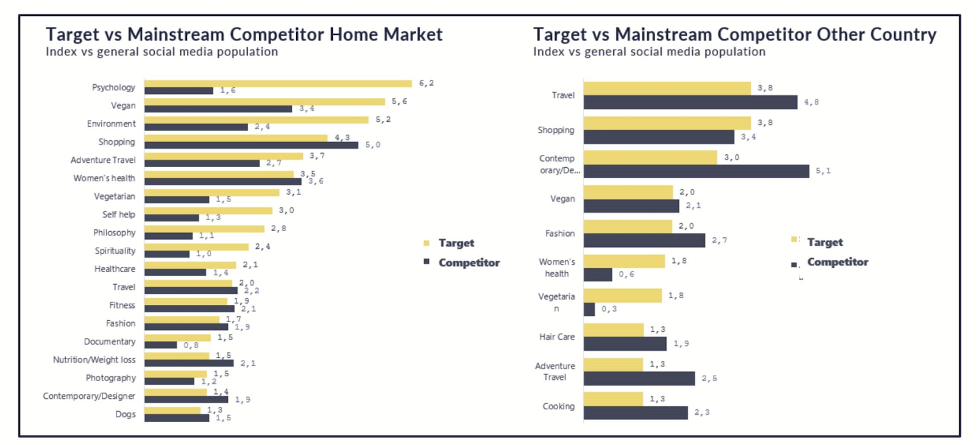Wouldn’t it be great to be able to read consumers’ minds? To know exactly why they buy and what are thinking about your business and products at any given moment. Well, by using psychographic segmentation, mind reading is almost a reality.
Sadly, it is not quite in a Professor X kind of way just yet, but psychographic segmentation can help you figure out what makes your customers tick and act. It deals with the “why” behind the decisions your customers make.
Sounds magical, but it is actually all analytical reasoning. We’ll guide you through it all.
Psychographic Segmentation Definition
Psychographic segmentation is a type of market segmentation based on the psychological characteristics of customers.
Its main purpose is to reveal the “why” behind purchase decisions. And takes into consideration consumers’ values, opinions, aspirations, lifestyles, and behaviours.
It’s a market segmentation approach just like behavioural segmentation. Except that while behavioural segmentation deals with actions, psychographic segmentation deals with reasons.
To put this in layman’s terms, psychographic segmentation is separating your audience into distinct groups. These groups are based on the consumers’ purchase behaviour. Examples of such groups include categorisation based onlifestyle, social status, and attitudes.
It can sound odd that these things can influence customers’ buying decisions, but they do. Let’s take social standingas an example.
Some customers will only shop from certain brands that they feel are reflective of their social status. For instance, wearing just clothes designed by Channel or Dior.
It does not matter to these customers that other, less expensive brands may offer better quality clothes. These customers will only purchase from brands that they feel are at the level of their social status.
Access to this information enables your business to better understand how customers view your brand and products.
You can also identify pain points and address them. As well as discovering what customers want to achieve through purchasing your products.
Use all this information to market the same product differently to different segments of customers. This means you can hopefully sell more of a product to a more diverse group of people, without making material changes to the product.

Why understanding customer behaviour is vital for your business?
Consumer behaviour is the result of a mix of motives and desires. In an era where customers have a myriad of choices at their disposal, knowing in detail what makes them act and buy is paramount.
Here is where psychographics come into play and uncover why clients choose your brand, why a certain product and what makes them come back.
Correctly depicting these patterns helps businesses make data-backed decisions, improve their offering, ameliorate customer satisfaction and sustain brand loyalty.
What is psychographic data?
The core heart of consumer behaviour is represented by psychographic data. It goes far beyond basic demographic and geographic information and dives deep into the meanders of the human mind.
And is looking to provide answers to the “why” not just “who” and “where”. In a word, it offers an overview of the audience’s interior world and empowers your business to create targeted marketing strategies with high precision.
Psychographic data includes variables like lifestyle, values, beliefs, interests, attitudes, and opinions.
Psychographic segmentation vs. behavioural segmentation
Behavioural segmentation focuses on customers’ conduct on how they interact with your business. It groups consumers based on purchasing habits, brand loyalty, browsing habits, etc.
Practically behavioural segmentation considers mainly the behaviour of the customer, what he does, and how much spends, while psychographic segmentation deals with the psychology behind his actions.
Psychographic segmentation vs. demographic segmentation
Demographic segmentation divides the audience based on objective, clearly measurable characteristics like age, gender, education and income. While the psychographic segmentation deals with the psychic characteristics.
Demographic segmentation puts the light on “who” is the customer. Psychographic segmentation wants to provide answers on “why” a customer is buying and why he made that particular choice.
What Are the Variables Used in Psychographic Segmentation?
Psychographic segmentation is based on multiple variables that can be used. They come under various names, but they are all based around the same core ideas.
The main categories of variables are:
- Lifestyle.
- Activities – Interests – Opinions (AIO).
- Social status.
- Personality.
- Attitudes.
Though there are lots of variables available, you do not need to use all of them. Many of them overlap and intertwine. But if they do not apply to your customers nor help you understand them better, do not attempt to force them into a psychographic profile.
Lifestyle
Our lifestyles are a huge defining part of who we are and therefore the products we consume. Our clothes are generally determined by our lifestyle choices, which is why our styles and tastes change throughout our lives.
But what do we mean by lifestyle? It is kind of a vague, all-encompassing term that could refer to many things.
Let’s take an example.
Travel preferences are tightly related to a person’s lifestyle. Some favour luxury vacations, others cultural tours, others backpacking experiences, others nature explorations.
Such details help travel businesses cater their offer in accordance with the profile of their customer traveller and craft adequate marketing campaigns.
Activities – Interests – Opinions
Activities are pretty straightforward to build a psychographic profile out of. Do you want to find out what activities your customers enjoy and how often? How much of a financial commitment have they made to said activities?
Activities may cover work, hobbies, holidays, club memberships, social events, community, and entertainment.
Knowing what activities your customers enjoy will reveal a wealth of insights about products they are likely to purchase due to this.
For instance, active people are more likely to buy sports gear, while sedentary people may spend more on high-tech home gadgets.
Interests refer to the degree of engagement customers have with a particular thing. This could be activities or a broader interest like family, food, home, work, community, fashion, or recreation.
You can use this to narrow down more specific products your audience may be interested in.
Opinions. We all have them. About ourselves, others, social issues, political issues, economic issues, businesses, services and products, etc.
We also hold on to some opinions stronger than others, depending on our beliefs and values, and generally by how much they affect us.
In business terms, if someone has a poor opinion of a brand, it is almost impossible to change their minds and selling to them is futile.
Social Status
Social status determines so much of our preferences around the products we use. Each class has predetermined preferences that they may not have even consciously considered.
For businesses, this can be a vital tool in knowing who to target and who would never be interested. Or if you have a product that is helpful to all social classes, it can help you target your messaging to each different social class.
As an example, very wealthy people prefer in general luxury cars, luxury hotels, the best clothes, the most expensive jewellery, certain brands, etc. A top-level jewellery brand will target the wealthy and elitists. Not middle class.
Personality
You can group your audience according to their personality traits. Meaning you take into consideration factors like motivations, beliefs, morals and general perspective on life.
Examples of defined personality traits could be creative, analytical, friendly, extrovert, introvert, organised, achiever, belonger, etc.
Customers’ personalities influence greatly purchasing behaviour.
For instance, knowing if your customers fall into introverted or extroverted groups changes significantly your marketing approach.
Introverts enjoy mostly solitary activities and are more oriented towards their inner side, while extroverts are champions of social interaction and more oriented towards the exterior side.
The first personality group would be more receptive to personalised 1-to-1 communication, while the second would appreciate more energetic and colourful campaigns meant for a community.
Attitudes
Attitudes are intricately linked to our opinions and beliefs. They are usually moulded by our cultural background and the way we were raised. Your audience will be made up of a wide variety of attitudes.
Knowing your audience’s attitudes can bring valuable insights. Use these to target the right customers with the right messaging.

Benefits of Psychographic Segmentation
Psychographic segmentation has plenty of benefits besides the obvious benefit of better understanding your audience. It is what you do with those insights that bring the biggest benefits.
Measure and Track Consumer Buying Behaviour
Psychographic segmentation delivers insights into why customers behave the way they do, enabling the discovery of customer motivations. You can use this to effectively measure how well your marketing strategies are resonating with your audience.
Being aware of your audience’s values, attitudes, opinions, and interests you have the possibility to create very precise and targeted campaigns.
As customers notice marketing approaches that are relevant to them, there are higher chances of catching their interest and attention. Thus, the engagement will increase.
Consumer-Centric Strategies
Psychographic segmentation allows you to shape your business and marketing strategy more effectively. Meaning, you can launch marketing campaigns that resonate better with customers’ subconscious needs.
Armed with this advanced knowledge you can design services and products that respond better to the specific needs of your clients. Increasing the chances of their success in the market.
Also, prioritise the development of those features that are most priced by your audience. Consequently improving the resource allocation. And earn a competitive edge as you develop a unique value proposition that meets the customers’ intricate desires.
Higher ROI
Because you can target your marketing campaigns more effectively, you should in theory see a better return on investment (ROI). This is particularly true if you can reduce paid channel costs, or more efficiently target them to your audience.
Improved Predictability
Other types of marketing segmentation change over time. They can be random and unpredictable and therefore difficult for businesses to strategise for.
Because much of it is based on our personality, attitudes and social status, these things rarely change and are more constant.
This allows businesses to segment their customers and build a detailed long-term strategy more accurately.
Strengthen brand loyalty
In our fast-paced century, loyalty is hard to get and easy to lose. But, psychographic segmentation has the capacity to keep the odds in your business’s favour.
Use it to craft personalised experiences via loyalty programs, customised recommendations or exclusive offers.
To create a consistent messaging that is in line with your customers’ expectations and beliefs. And to connect with quality like-minded clients that form a strong community.
In time, such an approach will build trust and strengthen loyalty towards the brand.
Psychographic Segmentation Doesn’t Have to Be Time-Consuming
You can build the psychographic profile of your customers in a variety of ways.
- There is the old-fashioned way of conducting traditional market research: you can do this through surveys, interviews, focus groups and observations. Though it is time-consuming, this approach can give you valuable information about your audience.
- Alternatively, technology allows us to take shortcuts and use an insight platform to gain such information. This technology, like AI Symanto Insights Platform, can collect and analyse text data far faster than traditional routes and may reveal hidden insights that traditional market research is unable to spot.
Nowadays, you can analyse vast amounts of psychographic data in minutes. Because of the huge amounts of data available, you can build segments and target them more accurately. It is a technology well worth investing in for your business.
When done correctly, psychographic segmentation is a powerful tool. But what is more important is what you do with the information you obtain.
As a general idea, psychographic segmentation analyses texts to discover the personality traits and tonality of customers. Subsequently, it merges these findings with consumers’ opinions and sentiment analysis.
Then it categorises the customer base into four main segments based on their predominant action: critics, at-risk, loyalists, and ambassadors.
At Symanto, we aim to deliver even more personalised psychographic segmentation.
Meaning, our algorithm considers additional consumer traits such as personal motivations and interests.
Symanto uses a personality traits model constructed on Carl Jung’s psychological classifications. And a communication style model based on the communication theory of Friedemann von Thun.
Significant Benefits
- Uncover unique competitive insights by comparing consumer traits and loyalty for various products and brands.
- Gain a deep understanding of vital elements like customer needs, drivers and dropdowns. And craft a powerful marketing strategy that speaks to the sentiments of your audience.
Symanto’s psychographic segmentation differentiation elements
Our impressive psychographic segmentation process includes:
- Proprietary psycholinguistic analytics – profile and group customers based on tiny conversations of 10 words.
- Instant segmentation – AI-powered capabilities to segment large customer databases in real time.
- GDPR and privacy compliance – personal data is not needed, we work with anonymised data.
Insights are pointless without action to follow them. For example, imagine a travel business that targets its audience through personality types and then, uses this information to offer last-minute deals to extrovert or impulsive personality types. A win-win strategy.
How you use psychographic segmentation insights will be unique to your business. Why don’t you request a free personalised demo and find out for yourself?
Discover how Symanto can help you to grow your business in a very short time and in a cost-efficient way.
How to Do a Psychographic Segmentation?
Let’s look at some practical elements you need to consider when conducting this type of segmentation.
Data collection ways
The basis of a solid psychographic segmentation is the quality and accuracy of data concerning your audience’s values, opinions, lifestyles and behaviours. Some common methods to collect data are:
- Social media text analysis. Today consumers express their ideas, preferences, opinions, interests and experiences on social media. Collecting these texts, and analysing them through the lens of sentiment analysis surface unique and valuable insights. Social listening tools bring high value in such cases.
- Questionnaires and surveys. A classical method still relevant today. Directly ask your audience about her preferences, interests, and opinions using well-thought surveys.
- Focus groups. Another method heavily used for audience research. Organising discussions with small groups representative of your target audience delivers a wealth of psychographic data.
Techniques to analyse the data
The next step after psychographic data collection and data cleaning is to extract its meanings. For this, several techniques are used:
- Cluster analysis. It essentially refers to grouping together similar elements, spotting patterns and segmenting the audience considering analogous aspects. For example, you may identify a cluster of tech-savvy customers or nature enthusiasts.
- Factor analysis. Most often psychographic data has a high degree of complexity and involves many variables. Factor analysis has the purpose of reducing this complexity by determining elements that clarify the correlations and links among variables.
- Create buyer personas. Buyer personas are fictional representations of customer segments. They include demographic and psychographic characteristics representative of each segment. Personas are very useful in marketing in order to conceive tailored marketing campaigns.
Psychographic Segmentation Examples
The benefits of psychographic segmentation are not just related to understanding better your target audience and creating campaigns that speak directly to their expectations. But also uncovering powerful insights that lead to your business success.
Symanto’s Psychographic Segmentation in Action

For a company active in the nutritional supplements industry, Symanto was invited to analyse and dig deeper into the company’s audience segments, needs, motivations, and behaviours. And to make a comparison with the competitors’ audience to substantiate the audience’s fit to its claims.
Symanto first performed a segmentation based on needs, resulting in the following segments well-being, health, and fit and shape.
Then used
- Our multi-dimensional micro-segmentation approach,
- Proprietary psychographic profiling,
- Advanced mining of social media to identify interests, socio-demographics, brand affinities and product references.
To extract valuable insights like:
- The company’s target audience was very loyal in their home country but displayed just a “shopping around” attitude in other regions.
- Hidden areas of expansion like a particular product segment that was not covered by the company while that competition was doing it.
- Assess the segment share variation by country – it has heavy implications for international expansion strategy.
Apple’s Famous “Think Different” Campaign
When conceiving this campaign Apple aimed to celebrate the innovation and creativity and not necessarily the features of their high-tech products.
They analysed in detail their audience and concluded that it was composed of creative, vanguardist and somewhat rebellious persons.
To appeal to this psychographic, Apple chose to emphasise personalities like Mahatma Gandhi and Albert Einstein. Looking to inspire this audience to adopt Apple’s products.
It was a spectacular campaign that wrote history, revolutionised the industry and positioned Apple as a leader of high-tech innovation. Through this campaign, they crafted a brand identity that connected highly with this particular psychographic.
“Just Do It” by Nike
Nike’s slogan goes far beyond sports and its products, it speaks about a winner’s attitude and mindset.
They realised that this was a defining psychographic trait of their audience, sportsmen and wanna-be sportsmen or just sports enthusiasts.
And they have used this insight to tackle the psychology of achievement, inspiring their audience to fight for their dreams and push boundaries.
Nike’s message became a synonym of their brand worldwide, transcended mere sportswear and built a bridge to people’s aspirations. Based on the psychographics of ambition and concentration. Nike’s slogan speaks to the champion mindset.
Take Away
Psychographic segmentation is not just another tool, it is capable of delivering strategic insights to lead your business to a brighter future.
Understand your audience deeper, create memorable campaigns, polish products that resonate better with your customers, and inspire loyalty. And follow the model of renowned brands who leveraged the power of psychographics to skyrocket their success.

